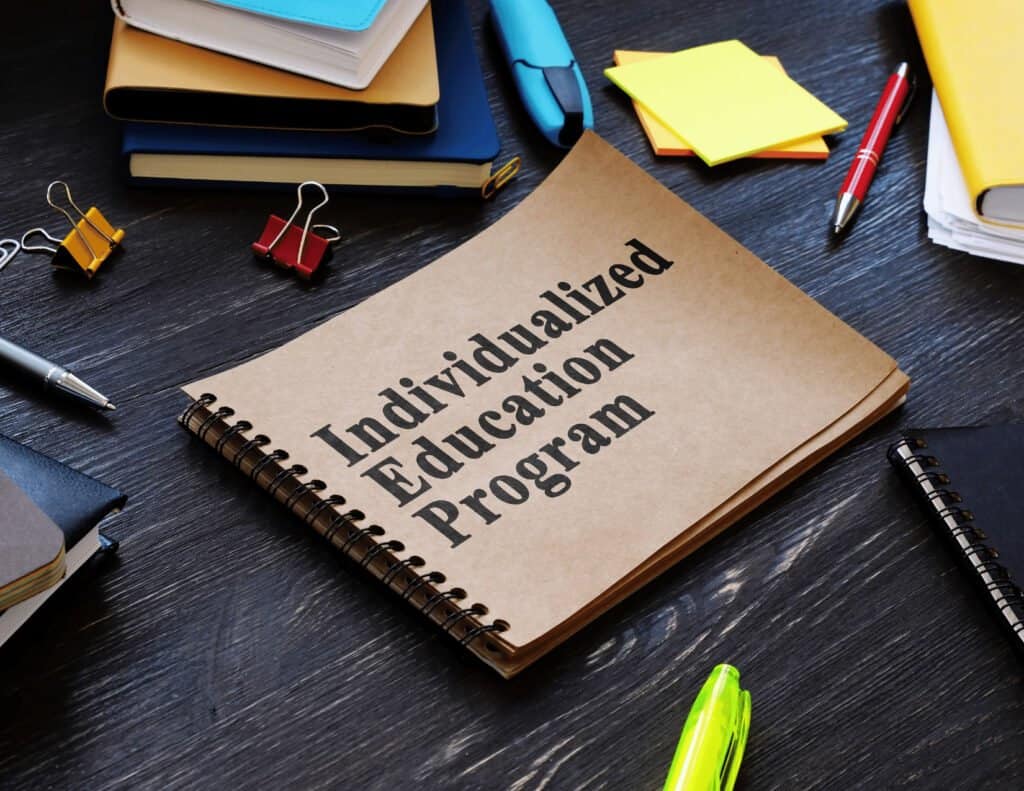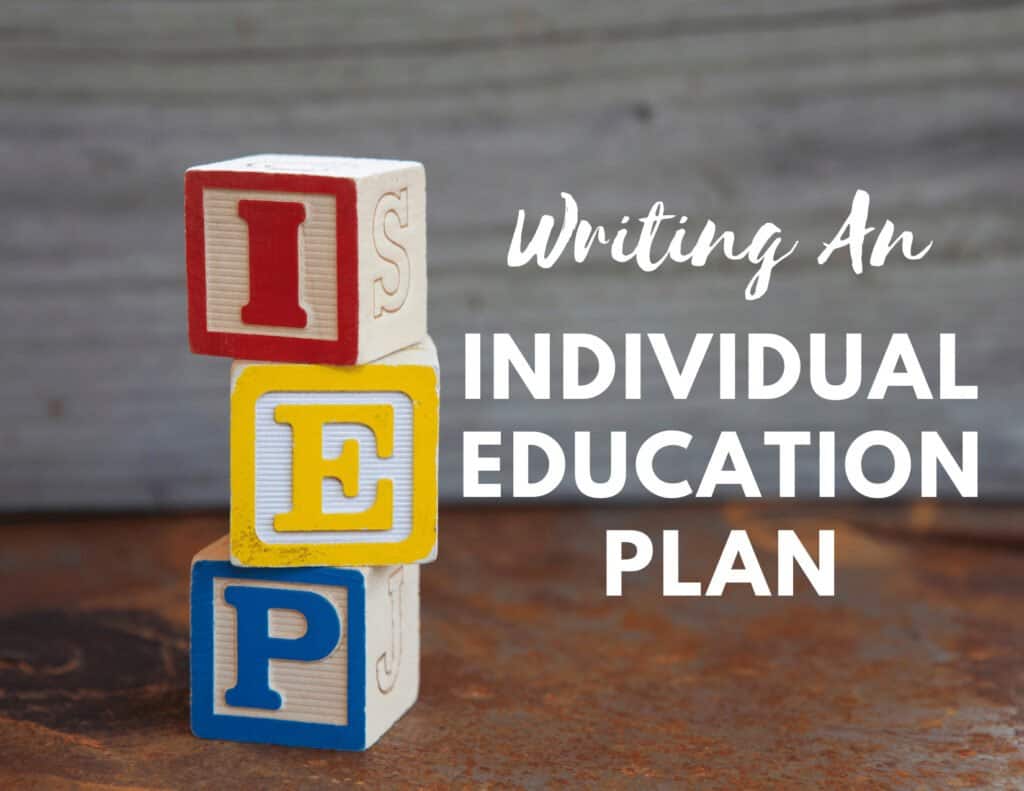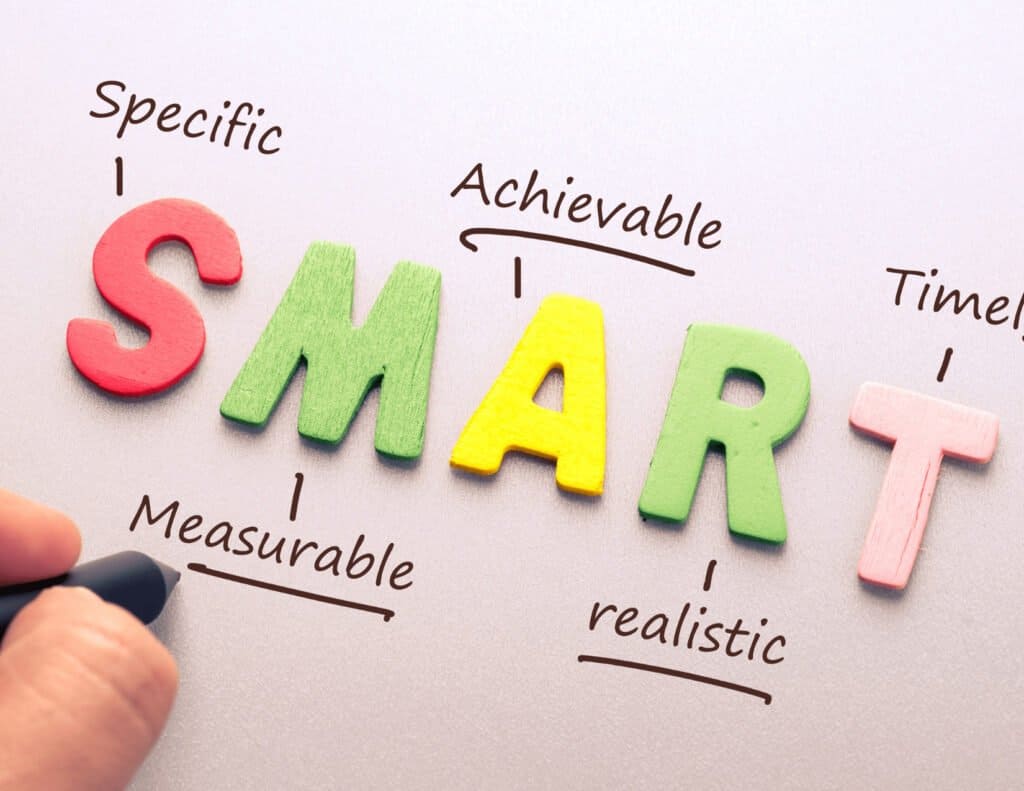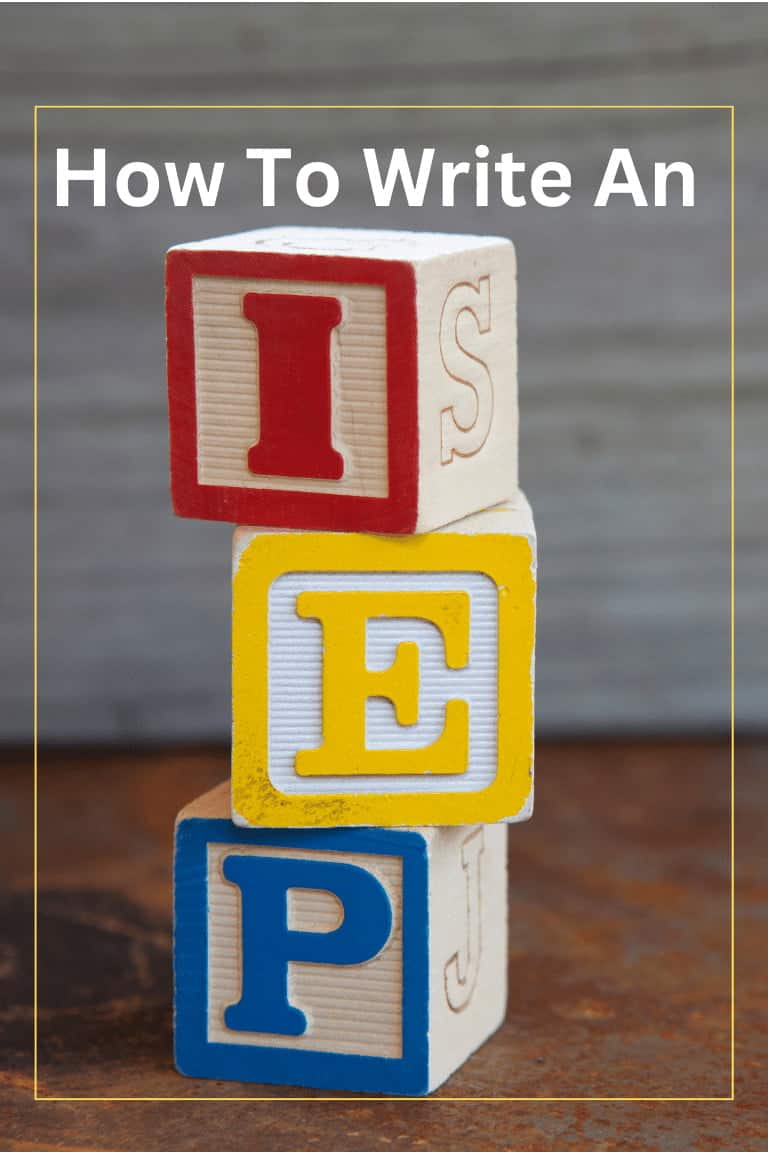Do You Need To Know How To Write An IEP?

One of the most frustrating and hardest things to understand as a special education teacher major was how to write an IEP.
This falls under the top things you need to know before becoming a special education teacher.
LOL! Ok, so I am being a little dramatic, but I would have loved the warning.
Unfortunately, things didn’t get better during my first couple of years of teaching. I still didn’t know how to write an IEP successfully with understanding.
The only thing worst than not knowing how to write an IEP is having to implement a poorly written one.
I am still trying to determine which is worst after over 15 years of teaching special education.
Nevertheless, like with all things, I became better at writing them the more I did them.
I hope to shorten your learning curve by showing you not only how to write an IEP but to answer some commonly asked questions about them.
By the time you finish reading this, you will have not only increased your ability to write an IEP, but to understand its components, and the why behind them.
Let’s go!
How To Write An IEP 101
Step 1 Knowing Who To Send Meeting Invitations To
Most people would not consider this part of how to write an IEP. However, it is a part of the IEP process. It shouldn’t be neglected.
You, as the teacher, will carry a heavier load in leading the IEP process and writing the IEP. However, it’s a team effort.
So, the first step is to determine who these team members are so you can send a Notice of Meeting to them.
The Student
First and foremost is the student. The student is the most important person on the team. As well as they should be.
After all, this is about them. Their voices should be heard.
I’ve had students as young as eight years old attend and participate in their IEP meetings.
I’ll give you a few examples a little later on how you can help make them a meaningful, contributing members of the team.
Of course, if they are not interested then they shouldn’t be forced. However, older students should be encouraged to attend and participate in meaningful ways.

The Parent or Guardian
Parents and guardians have the right to participate in developing the IEP as well.
Sometimes you have to work around family dynamics because not all students live in a two-parent household.
You also may have students whose legal guardians are other members of their families. For example, some students may live with a grandparent, aunt, adult sibling, or guardian.
And if English isn’t the first language, then you have to request a translator. This will remove any barriers to having the family participate in the process.
All Teachers Of The Student
Commonly the child’s classroom teacher and special education teacher attend, however, all teachers that serve the student should be invited and asked to participate.
I should add, that this includes all teachers who teach classes covered by goal areas.
Also, all teachers who teach classes where the child is entitled to use accommodations.
It’s important to also note, that these are the only teachers who should have access to the student’s IEP.
Specialists Personnel
What are specialists personnel?
Because of the various needs of students with learning differences (that’s what I like to call it), many also need help from people who are in specialized fields.
These specialists include, but may not be limited to:
- Speech Language Pathologists
- Occupational Therapists
- School Psychologists
- Guidance Counselors
- Social Workers
- Physical Therapists
- School Nurses
- Transition Specialists
- Career Coaches
It’s really important that any of these professionals who may be serving the students participate in the IEP process.
Now some of these people may or may not attend the IEP meeting, but they should communicate information about the student as it relates to how they may be serving them.
It’s important that you understand the services and the information communicated by these professionals if they do not attend the meeting.
It will be your responsibility to update the team (student, parent/guardians, teachers and other specialists) who actually do attend the meeting.
IDEA (Individual with Disabilities Education Act) requires that these people receive a formal invitation to the meeting in a timely manner.
Most school systems have a notice of meeting that you will send out.

Parts of an IEP (How To Write An IEP)
Before we jump into the actual writing of the IEP and examples thereof, it’s important that you understand that there are several parts to an IEP. These include:
- Present Levels of Academic Achievement and Functional Performance
- Annual Goals
- Progress Tracking
- Duration of Services
- Participation in Mainstream Classrooms
- Testing Adaptations
- Transition Goals and Services
In addition, forms from one state to another or even one district to another will look different.
The important thing to understand is all IEPs are expected to contain certain information. So don’t focus on the fact this isn’t in “form” fashion, learn the parts.
Step 2 How to Write An IEP Step by Step
2a Present Levels of Academic Achievement and Functional Performance
This part of the IEP focuses on the student’s current levels of academic and functional performance.
Acronyms used in place of its full name include PLOP, PLEP, PLAAFP. It seems like every district does its own thing.
PLAAFPs must include three parts:
- Current performance,
- Learning strengths
- Parent concerns
- Standardized assessments like the state or district assessments
- Universal screening and progress monitoring data
- Instructional preferences
- Learning rate
- Strengths and weaknesses
- Social/emotional Issues
- Vocational/career interests/skills related to those interests (age 14 & up)
- The impact of the exceptionality, and
- What does one see about this student that is different from typical peers that are a result of the exceptionality?
- How is the student’s exceptionality getting in the way of being involved in or having access to the general curriculum?
- How is the student’s exceptionality getting in the way of progressing in the general curriculum?
- Baseline data for identified needs.
- Specific – must be clear about what is being measured.
- Objective – you and a colleague should both be able to score/rate/measure it and come up with the same information.
- Measurable – something that can actually be measured and be able to show small increments of growth, not broad concepts.
- Able to be given frequently – you need to be able to collect the information in the same way at least as often as you send out progress reports and able to show progress over those short periods of time.
This section should read like a narrative painting a clear picture for both educators and parent(s) or guardians on what the students can do as well as deficit areas.
Generally, it’s the first part after general information about the student and it lays the foundation for all other decisions in the IEP.
It should indicate how the student’s learning difference is impacting his or her progress and growth in the general education curriculum.
Here is an example of how you write this part of the IEP.
__________________
Sara is in the 8th grade in a transitional class for students with autism. Her most recent grades are Reading 91, Language Arts 92, Math 92, Science 91, and Social Studies 96. Georgia Milestones testing (April 2019) yielded the following scores: English Language Arts 422 (increased from 379 in 2018), Math 437 (slightly decreased from 440 in 2018). Both scores fall in the Beginning Learner range. The English Language Arts portion of the test also yielded a Lexile score of 870, which falls in the range of students reading starting at the 5th-grade level.
There is a discrepancy noted between this score and the one provided by the i-Ready Screening administered in September 2019. The screening yielded a score of 560, which falls in the range of students reading from the 3rd through 4th-grade levels. A further discrepancy is noted in the reading inventory from Read 180, which yielded a Lexile score of 146, which falls in the range of students reading at or below first grade. Because Lexile scores are listed in a range, with some overlap from one grade to the next, it will be necessary to focus on specific skills (comprehension, details, story analysis, and compare/contrast) to help Sara develop in her individual areas of need. iREady Reading Assessments also placed her in the following grade levels by domain: Phonological Awareness (PA) Tested Out, Phonics (PH) Tested Out, High-Frequency Words (HFW) Tested Out, Vocabulary (VOC) Grade 2, Comprehension: Literature (LIT) Grade 2, and Comprehension: Informational Text (INFO) Grade 2. iREady Math Assessments also placed her in the following grade levels by domain: Number and Operations (NO) Grade 1, Algebra and Algebraic Thinking (ALG) Grade 1, Measurement and Data (MS) Grade 1, and Geometry (GEO) Grade 2.
Parental concerns regarding their child’s education: Ms. Range said she wants to continue working on Sara’s reading comprehension and encouraging her to speak more. She also noted that Sara has an interest and ability in using her keyboard to make beats. While discussing the schedule for high school, she had questions about elective courses. Mr. Wenn provided contact information for Jackson High School’s IST (who could not be present) to answer further questions.
Impact of the disability: Sara speaks barely above a whisper. She will indicate she understands an assignment when she doesn’t. It often takes hours to finish simple tasks unless being pushed along. She isolates and in activities that engage, she moves extremely slow and ridged. Sara demonstrates deficits are in communication, socialization, and a restricted pattern of interest. Sara’s deficits across the academic domains and in the areas of communication interfere with her ability to benefit from the general education curriculum.
__________________
Most teachers will send a draft IEP home asking parents what their concerns are so that statement is given before the meeting.
In addition, they are to review the goals to ensure they are in agreement about them. This is how to ensure parent input without putting the parents on the spot to come up with something.
Lastly, if you would like to take an even further deep dive into learning more about PLAAFP Kansas Department of Education has a wonderful resource.
2b Measurable Annual Goals
Goals should be written in areas of identified need in the student’s academic performance and functional performance.
Side Note: Doing a goal for every academic and functional need can be extremely time-consuming to write and track. Not to mention, this might set the student up for failure.
As the old saying goes, the best way to eat an apple is one bit at a time. Therefore, focus on at least one goal for each identified area of need on the student’s eligibility report.
For example, if the student has weaknesses in oral reading, reading comprehension, math computation, math problem-solving, and writing, then there should be at least one goal to address each area.
According to the IDEA, the goals you write should:
- “(aa) meet the child’s needs that result from the child’s disability to enable the child to be involved in and make progress in the general education curriculum; and
- (bb) meet each of the child’s other educational needs that result from the child’s disability;”
How to Write An Iep Goal
When writing your goals they should be SMART:
- Specific: Clearly stated with no room for misinterpretation.
- Measurable: The goal should be quantifiable, and progress should be easy to track.
- Achievable: The goal should be attainable — not outlandish or unrealistic.
- Relevant: The goal should contribute to your broader, overarching goals of increasing academic or functional skills.
- Time-bound: The goal should have a defined start and end date.

Example of a measurable goal:
When given word problems, Sara will independently solve and explain problems involving fractions by partitioning a whole into equal parts with 90% accuracy in 4 out of 5 trials within each 9-week period.
Remember the IEP goals should always be specific to the student and what their needs are.
Here is a resource that will help you think of good goals for your student. Click here!
2c How To Write An IEP: Progress Tracking
I hope you are starting to see how everything builds off of each other.
After writing your PLAAFP, you now know what area you need to target with your goals.
You know that all IEP goals need to be SMART.
Now, we will discuss what progress tracking is. You may hear people call it progress monitoring.
No matter if they use tracking or monitoring the process is the systematic and frequent assessment of your student’s progress against their annual goals.
This section is vitally important because it helps you ensure that your student is making adequate progress on their goals.
Here is where you will be specific about how and how often progress will be monitored on your student’s goal progress.
Be sure to include how, how often/when, and how that progress will be reported to parents.
I have always reported on my students’ goals at the same time they get their report cards.
There are many ways you are able to track your student’s progress. Sometimes your school district will have a uniform way of doing it, so don’t set in stone the following:
- Curriculum-based Measurement Testing (CBM)
- Learning Process Observations
- Formative Assessments
- Computer Adaptive Testing (CAT)
2d Special Education, Related Services, and Supplemental Aids & Services
Let’s start by defining these there:
Special Education Services is simply specially designed instruction that addresses the unique needs of a student eligible to receive special education services.
Related Services is defined according to the Individuals with Disabilities Education Act (IDEA), as any supportive service provided to a child with a disability that helps the child access and/or receive a benefit from special education.
The federal special education law lists the following as possible related services:
- Speech-language and audiology services
- Interpreting services
- Psychological services
- Occupational and
- Recreation, including therapeutic recreation
- Early identification and evaluation of disabilities in children
- Counseling services, including rehabilitation counseling
- Orientation and mobility
- Medical services
- School health and/or school nurse services
- Social work services
- Parent counseling and training
What are supplement aids and services?
Supplemental Aids and Services means aids, services, and other supports to enable students with disabilities to be educated with nondisabled students to the maximum extent appropriate in the least restrictive environment.
Examples of supplemental aids and services are:
- a note taker
- assignment of paraprofessional staff
- assistive technology
- adaptive equipment
In the example of the PLAAFP, I provided above about Sara, if she was in the general setting she would benefit from a paraprofessional staff to take notes because she writes so slowly.
Here is a wonderful resource to help you identify aids or services your students may need. Click here!
Accommodation and Modifications
This is also usually the area where you will list any accommodations and modifications.
The International Dyslexia Association has a great definition for “accommodation” that makes it easier to differentiate between an accommodation and a modification. They say, “Accommodations are adjustments made to allow a student to demonstrate knowledge, skills, and abilities without lowering learning or performance expectations and without changing what is being measured (e.g., providing text in audio-format when academic knowledge [e.g., history, biology, literature] is the target skill being measured).”
On the contrary, modifications are changes in what the student is expected to learn.
It’s important that you know the difference because students who are working toward a general education diploma aren’t supposed to have their work modified.
Some examples of modifications are alternate books, pass/no pass grading, reworded questions in easier language, and so on.
This is an extremely important component in the process of how to write an IEP that is effective.
2e Duration of Services
IEPs are very time-sensitive and they last a calendar year.
In this section of the document, you will state the date upon which services will begin and the IEP will go into effect.
According to the IDEA law, it should also detail “the anticipated frequency, location, and duration of those services and modifications.”
It has been my experience that this information is at the top along with the student’s demographic information.
2f Instructional Setting or Placement
Here you will identify where the student will be receiving services or the learning placement.
The placement may be in the general education classroom, the special education classroom, a combination of both, or another appropriate learning placement for that student.
This is where you will put an explanation of the extent to which the child will not participate with non-disabled children in the regular class or activities if it is applied.
2g How To Write An IEP: Testing Adaptations
In this section, you will document the accommodations needed for test taking.
Examples of the wide range of testing accommodations that may be required include:
- Braille or large-print exam booklets;
- Screen reading technology;
- Scribes to transfer answers to Scantron bubble sheets or record dictated notes and essays;
- Extended time;
- Wheelchair-accessible testing stations;
- Distraction-free rooms;
2h Transitional Goals and Services
Out of all the parts and everything you need to know about how to write an IEP, this part is my favorite.
I’ve always worked with high school students so a big part of what we do is help them transition to post-secondary options.
The transition plan includes postsecondary goals and transition services that will be needed to help the student reach their goals beyond high school.
How to Write an IEP Transition Goals
The goals in the IEP transition plan state what a student wants to do or achieve after high school.
So you are working on goals that will help the student meet his/her postsecondary goals.
You will normally consider the following area to develop goals based on what the student wants:
- Vocational training (e.g., learning a trade)
- Postsecondary education (e.g., college or other schooling)
- Jobs and employment.
- Independent living, if needed.
Here are some examples of transition goals.
Frequently asked questions:

What is Assistive Technology in special education?
According to ATIA, assistive technology (AT) is any item, piece of equipment, software program, or product system that is used to increase, maintain, or improve the functional capabilities of persons with disabilities.
AT can be…
- low-tech: communication boards made of cardboard or fuzzy felt.
- high-tech: special-purpose computers.
- hardware: prosthetics, mounting systems, and positioning devices.
- computer hardware: special switches, keyboards, and pointing devices.
- computer software: screen readers and communication programs.
- inclusive or specialized learning materials and curriculum aids.
- specialized curricular software.
- electronic devices, wheelchairs, walkers, braces, educational software, power lifts, pencil holders, eye-gaze and head trackers, and much more.
Assistive technology helps people who have difficulty speaking, typing, writing, remembering, pointing, seeing, hearing, learning, walking, and many other things.
Different disabilities require different assistive technologies.
What is the difference between accommodations and modifications?
I talked about this above a little, however, I like the way Reading Rockets explained it…
Accommodations remove learning barriers in the classroom to provide every child with equal access to learning. An example is offering an audio version of classroom text for a student with dyslexia or visual support for children with ASD. Modifications are changes to what a child is taught and expected to do in class. For example, a student who struggles with spelling may be tested on a different set of words than his peers.
What is the least restrictive environment for students with disabilities?
The least restrictive environment (LRE) is not a place, but a principle that guides a child’s education setting. It means that kids who receive special education should be in the same classrooms as other kids as much as possible.
I hope you have found this how to write an IEP guide helpful. Please don’t hesitate to leave questions below.

Thank you for sharing this information. I wish I had this resource when I first started teaching back in 2014.
You are so welcome. 🙂
Thank you from of the bottom of this new Special Ed teacher’s heart!
🙂 Thank you for what you do!!!